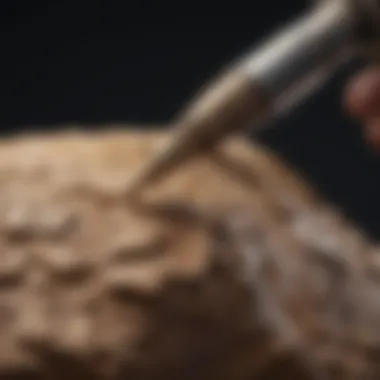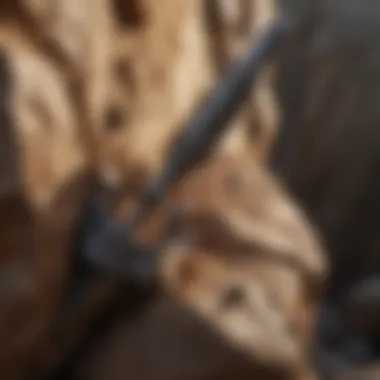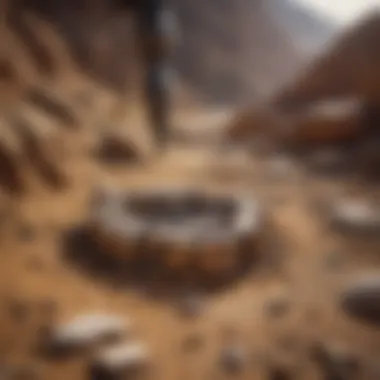Unveiling the Revolutionary Side Drill Tool for Rock and Fossil Enthusiasts


Rock and Fossil Identification
As a rock and fossil collector, having a deep understanding of the types of rocks and fossils is fundamental. Rocks can be categorized into various groups, including igneous, sedimentary, and metamorphic rocks, each with distinct characteristics and formation processes. Fossils, on the other hand, offer valuable insights into past life forms, with categories such as petrified fossils, mold fossils, and cast fossils. Identifying these specimens requires keen observation and knowledge of the unique traits that set them apart. Utilizing specialized tools for identification, such as hand lenses and field guides, enhances the accuracy of classification.
Collecting Tips and Techniques
Exploring prime collecting sites is a thrilling aspect of rock and fossil hunting. By following best practices for collecting, enthusiasts can ensure the preservation of specimens while respecting the environment. Locating ideal sites involves research, field exploration, and networking with fellow collectors. Safely extracting specimens requires precision tools like rock hammers, chisels, and brushes. Adhering to ethical practices maintains the integrity of both the collection process and the location.
Preservation and Display
Preserving rocks and fossils is paramount to maintain their integrity for future generations. Various techniques, such as encapsulation in resin or careful cleaning using gentle tools, help prevent deterioration. Proper storage methods involve placing specimens in acid-free containers or display cases to shield them from environmental factors. Creative display ideas, such as mounting fossils on stands or arranging rocks in themed collections, add aesthetic value to exhibits and showcase the beauty of these natural treasures.
Geological Insights
Delving into the geological aspects of rocks and fossils unveils a world of historical significance and scientific wonder. Understanding geological formations and processes sheds light on the conditions under which these specimens were created and preserved. Studying notable discoveries in the field not only enriches one's knowledge but also highlights the impact of geological findings on our understanding of Earth's history. Unraveling the mystery of these treasures offers an immersive journey into the realm of geology, promising endless exploration and discovery.
Introduction to the Side Drill Tool
In the realm of rock and fossil collection, the side drill tool emerges as a groundbreaking instrument, poised to revolutionize traditional techniques. This pivotal introduction sets the stage for a comprehensive exploration of a cutting-edge tool that holds the key to unlocking new possibilities in the field. As rock and fossil collectors delve into the intricate world of extraction and preservation, understanding the nuances of the side drill tool becomes paramount. From its fundamental principles to practical applications, this section serves as a gateway to unveiling the intrinsic value that the side drill tool offers to enthusiasts and professionals alike.
Understanding the Purpose of Side Drilling


Enhancing Precision in Core Sample Extraction
Embarking on a journey towards enhancing precision in core sample extraction is pivotal for elevating the quality of findings in rock and fossil collection endeavors. This aspect of side drilling epitomizes meticulous attention to detail, allowing collectors to extract core samples with unparalleled accuracy and finesse. The key characteristic of precision enhancement lies in the ability to achieve pristine specimen extraction, minimizing damage and maximizing sample integrity. By prioritizing precision, collectors can unravel the hidden beauty of rocks and fossils with a level of accuracy that is unparalleled in traditional drilling methods.
Exploring Alternative Drilling Techniques
Diversifying strategies through exploring alternative drilling techniques presents an exciting avenue for enthusiasts to broaden their skill set and approach. Venturing beyond conventional methods, collectors can uncover innovative solutions that cater to varied geological challenges. The allure of alternative drilling techniques lies in their adaptability to unique rock formations, offering a versatile approach to extraction. This section delves into the unique features of such techniques, shedding light on their advantages and potential limitations, ultimately enhancing the repertoire of options available to rock and fossil collectors.
Evolution of Drilling Technology
From Traditional Drills to Innovative Side Drilling
The evolution of drilling technology encapsulates a transformative journey from the familiarity of traditional drills to the cutting-edge realm of side drilling. This progression signifies a paradigm shift in the approach towards excavation and sample extraction, reflecting an intent to optimize efficiency and outcomes. A key characteristic of this evolution lies in the seamless integration of technology with tradition, merging the best of both worlds to streamline processes. By transitioning to innovative side drilling, collectors can harness the benefits of improved precision, reduced environmental impact, and enhanced productivity, underscoring the indispensable role of technological advancements in modern rock and fossil collection practices.
Design Features and Functionality
Mechanics of the Side Drill Tool
In-depth Analysis of Blade Configurations
The blade configuration of a side drill tool is a fundamental aspect that significantly influences its cutting performance and overall functionality. The in-depth analysis of blade configurations delves into the specific design elements that dictate the tool's cutting precision, material compatibility, and versatility. By understanding the key characteristics of various blade configurations, users can make informed decisions on selecting the most suitable option for their drilling requirements. Whether it's a serrated edge for enhanced grip or a smooth blade for clean cuts, each configuration has its unique advantages and disadvantages that must be carefully considered based on the intended use case.


Optimizing Speed and Control
Optimizing speed and control is paramount when it comes to maximizing the efficiency of a side drill tool. This subsection explores how advancements in tool design have focused on enhancing speed without compromising on precision and user control. The key characteristic of optimized speed and control lies in the tool's ability to maintain consistent performance across different drilling conditions, ensuring smooth operation and accurate results. By highlighting the unique features that contribute to improved speed and control, readers will gain a deeper appreciation for the technological innovations driving the evolution of side drilling tools in the context of rock and fossil collection.
Ergonomic Considerations
Handle Design for Comfort and Stability
The handle design of a side drill tool plays a crucial role in user comfort, stability, and overall usability. This section delves into the specific aspects of handle design that prioritize ergonomics, ensuring that collectors can work for extended periods without experiencing discomfort or fatigue. The key characteristic of a well-designed handle lies in its ability to provide a secure grip, reduce vibration feedback, and optimize the distribution of weight for balanced handling. By exploring the unique features that define handle design for comfort and stability, readers will gain insights into how ergonomic considerations can significantly enhance the drilling experience, making it more efficient and enjoyable.
Weight Distribution for Precision Drilling
Achieving precision drilling requires careful consideration of weight distribution throughout the side drill tool. This subsection examines how proper weight distribution contributes to improved drilling accuracy, reduced strain on the user, and overall operational efficiency. The key characteristic of weight distribution for precision drilling lies in balancing the tool's weight to ensure optimal performance while minimizing user fatigue. By exploring the unique features of weight distribution designs, readers can better understand how this aspect impacts the tool's maneuverability and its ability to deliver precise drilling results consistently. Understanding the advantages and potential limitations of weight distribution will empower collectors to make informed decisions when selecting a side drill tool for their rock and fossil excavation projects.
Applications in Rock and Fossil Collection
When delving into the realm of rock and fossil collection, the Applications section stands out as a pivotal segment in this article. It serves as a crucial bridge connecting theory to practicality, shedding light on how the side drill tool revolutionizes extraction processes within this specialized domain. By focusing on specific elements like preservation of specimens and precision sampling techniques, readers gain insights into the nuanced methodologies adopted by collectors. This section not only showcases the innovative capabilities of the side drill tool but also emphasizes the intricate balance between scientific preservation and effective collection strategies.
Preservation of Specimens
Minimizing Damage During Extraction


Miniaturizing harm during the extraction phase is paramount in the realm of rock and fossil collection. The meticulous process of minimizing damage during extraction epitomizes precision and care, ensuring that valuable specimens remain intact throughout the drilling process. This aspect's significance lies in its ability to preserve fossils and rocks in their natural state, allowing collectors to study them without distortions or alterations. The key characteristic of this technique is its surgical precision, enabling collectors to extract delicate specimens with minimal risk of breakage or alteration. It also provides a popular choice for this article due to its direct relevance to the core theme of enhancing extraction methodologies. One unique feature of minimizing damage during extraction is its adaptability, catering to a wide range of specimen types and compositions without compromising accuracy or efficacy.
Enhancing Display Options
Enhancing display options serves as a complementary feature to the preservation aspect, enriching the overall experience of collectors. By focusing on elevating the presentation of extracted specimens, this facet underscores the aesthetic appeal and educational value of rock and fossil collections. The key characteristic of enhancing display options is its ability to transform ordinary specimens into captivating exhibits, captivating both collectors and visitors alike. It is a popular choice for this article because it aligns with the goal of showcasing the full potential of the side drill tool in not just extraction but also in the way collected specimens are showcased. One unique feature of enhancing display options is its versatility, allowing collectors to tailor displays according to the specimens' characteristics and historical significance, thereby enhancing the storytelling aspect of each exhibit.
Precision Sampling Techniques
Extracting Core Samples with Minimal Disturbance
Extracting core samples with minimal disturbance represents a pinnacle of precision within the field of rock and fossil collection. This technique focuses on retrieving samples with unparalleled accuracy, minimizing any alterations to the surrounding geological matrix. Its key characteristic lies in its ability to extract samples intact, providing researchers with pristine cross-sections for analysis and study. A beneficial choice for this article, it aligns with the theme of optimizing extraction methodologies for geological research purposes. One unique feature of extracting core samples with minimal disturbance is its finesse, allowing collectors to harvest samples without compromising the structural integrity or context of the surrounding rock formations. This technique, while requiring precision, offers significant advantages in preserving the natural history encapsulated within each core sample extracted.
Best Practices and Maintenance Tips
In the realm of rock and fossil collection, adherence to best practices and maintenance tips is paramount for optimizing the functionality and longevity of tools like the side drill. This section sheds light on the critical significance of incorporating proper maintenance routines to ensure peak performance and durability. By following recommended guidelines with diligence, collectors can safeguard their equipment investment and enhance the overall efficiency of their activities. Delving into the intricacies of maintenance unveils a world of care and attention to detail that distinguishes amateurs from seasoned collectors.
Cleaning and Storage Recommendations
Preventing Corrosion and Ensuring Longevity
When it comes to the meticulous task of preventing corrosion and ensuring longevity of your side drill tool, attention to detail is key. Proper cleaning after each use and thorough drying are essential steps in mitigating the risk of rust and degradation. Investing in rust inhibitors or moisture-absorbing materials for storage can further safeguard against environmental factors that may compromise the tool's integrity. The choice of storage location, free from humidity and extreme temperatures, also plays a crucial role in maintaining the tool's pristine condition over time. By prioritizing corrosion prevention measures, collectors can extend the lifespan of their equipment and reduce the need for frequent replacements, ultimately saving both time and resources.
Sharpening and Blade Replacement
Maintaining Optimum Cutting Performance
Maintaining the optimum cutting performance of the side drill tool requires periodic sharpening and timely blade replacements. Dull blades not only hinder the precision and speed of drilling but also increase the risk of damage to specimens. By understanding the nuances of blade sharpening techniques and the signs indicating the need for replacement, collectors can ensure consistent cutting efficiency and minimal material wastage. The choice of replacement blades should align with the specific drilling requirements and material hardness encountered in rock and fossil extraction. While sharpening enhances the cutting precision, timely blade replacement guarantees the tool's overall effectiveness and prolongs its lifespan. Implementing a proactive approach to blade maintenance is a testament to a collector's commitment to excellence and proficiency in their craft.







